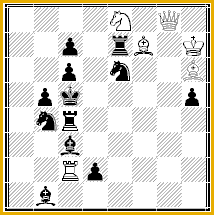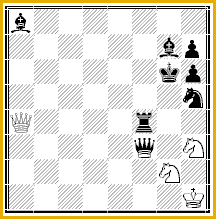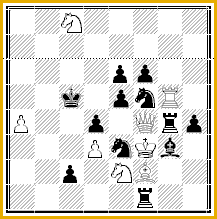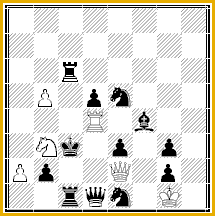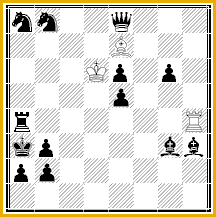BCPS AWARD: HELPMATES IN 2, 1999,
by C.J.Feather
from "The Problemist" vol 17 No 11 - September 2000It is just thirty years since some of my own first helpmates appeared in The Problemist; little did I think then that I should one day be the judge! Thus it was with pleasurable anticipation that I greeted my opportunity to judge this informal tourney for the first time. Alas, my expectation of a high standard was not fulfilled; indeed it was not easy to find any prizeworthy problems among the 65 competing works. Of course there were a good many satisfactory problems which were simply not of award standard, and the average quality was not bad However, there were also examples of shoddy construction, some of which were pointed out by solvers. Careful editing meant that there were almost no complete anticipations; but there were a good many very familiar ideas in new matrices a kind of work which calls upon composers' artisanship more than their artistry unless someth- ing quite special is added. The relatively few original ideas found either rather simple or else unbalanced expression. None of this is unique to this magazine, of course. In general far too little care and knowledge goes into the composition of helpmates in two, and judges who reward poor work merely convey the message that they would like more of the same.
Those awards which quote dozens of comparison problems in an attempt either to parade erudition or to forestall all possible criticism do not appeal to me very much I have checked the problems in my own h#2 collection and shall be happy to answer any queries. However, a few comments about anticipation are needed. First, the case of V. Kopaev. As some readers will know, his self plagiarisms have already been the subject of articles in Springaren and feenschach, and he has recently been banned from the former (see issue 79, p. 209). Column editors must decide for themselves when to ban composers with such propensities, but it is clearly a step which the editor of Springaren (Kjell Widlert) would not take lightly. As Kopaev is far from being a novice composer who might have some excuse, I will not grant him further coverage by going into details. Suffice it to say that he has published at least twelve problems similar to H2248, and I should be amazed if there were not more. There is one other case of self-plagiarism but I view this one quite differently: H2244 (Garai) is merely a slightly better (but heavier) version of a problem by the same author, 3rd Prize Scacco 1996. In the case of so prolific a producer (and onewho has no reputation for malpractice) I believe this must be ascribable to an oversight.
Some versions of competing problems were published along with the solutions. These are worthwhile in that they add to the interest of the solvers' comments, but they do not always show full understanding of the composers' intentions. Some judges are given to including such versions in awards. Indeed there have been cases where judges have provided and then rewarded their own versions, which is of course totally unethical! My view is that versions which are not made by the composer should be considered by the judge only if the composer makes a specific request to that effect and the author of the version agrees.
At this stage I should like to mention a few good problems which did not quite make it into the award. The impression of neatness given by H2247 (Jonsson & Wiehagen) cannot outweigh the BK twinning, especially since this task has already been shown in 3 solution form. H2261 (Janevski) is thematically very pleasing, but damaged by a repeated move and inhomogeneous play in part (b). The problem causing me the greatest headache was H2263 (Vieira) with its complex but very well signposted interferences; although its construction is as ingenious as it is elephantine, I could not in the end convince myself that its form was justified by its content. Incidentally, the remark by solver AE is incorrect there is no cycle, and interference with the Bal occurs only in part (b). Despite including my bê te noire, a repeated BK move the piquant H2308 (Molnár) would have been in the award if I had been able to convince myself that the presence of the two strictly unnecessary units Sa6 and Pd6 could be Justified. In the visually delightful H2325 (Garofalo & Pirrone) the fact that 2. e4 is the pawn's only move spoils the purity of the interference; I judged with regret that so unpretentious a work must be free of such easily surmountable failings if it were to be in the award. And now to the honoured problems...
Mario Parrinello, Italy
H#2 2 sols.1. h8
f8 2.
g7
e3# ;
1.
h4
f8 2.
f4
gl#.
This problem wins a prize for its dual avoidance at White's first move. If you try playing the wrong piece to f8 you will find that a black piece gets in the way and prevents the mate. The play itself is a combination of very familiar elements, but the blend is aesthetically satisfying (it is Black's need to make a useful interference which can create a harmful one if White is not careful) and the fact that the eR and S form an indirect battery is a particularly pleasing touch. The construction is good. Although it is regrettable that two white pieces need to be pinned, it provides an elegant solution to the technical difficulties, which are hardly apparent.
M. Persson & C. Jonsson
H#2 (b) Sh5->f7(a) 1. f7
c6+ 2.
f6
h4#
(b) 1.
f6
e4+ 2.
f5
gf4#
White and Black both unpin the same white piece, making a charming and novel combination with the black magnet effect. The purity of the thematic WQ moves is ensured by the possibility of 1... Qa6? in (a) and 1... Qc2? in (b), an indispensable feature which seems to have been ignored by solvers. However, the strategy is so simple that the problem seems too slight for a prize, especially since twinning is needed, a drawback in so otherwise elegant a scheme.
Michal Dragoun
H#2 2 sols.1. xg5
c3 2.
dxc3
c4#
1.
xf2
xd4# 2.
exd4
d6#
An original combination of motifs which seem to me to blend well together. The construction is constricted and not optimal (at least two units could be saved) but the idea deserves recognition.
1st Commendation H2278 - Janos Csak.
A work of great beauty and elegance which has all the qualities one expects of a prizewinner - except originality. Indeed the capture and double line opening effect with all the white moves played by the Q was first shown by the present writer in 1972 and certainly has not been ignored by other composers since then! Only the halfpin is new. You can add a black halfpin to almost anything, and the effect is sometimes highly artificial.Here it seems organic. I do not very much like the twinning, though lb3r2/4r3/2plk2S/2pss3/ 2Blqp2/4R3/8/3KQ3 H#2 - (b) Pc5>d6 (a) 1. Qxc4 Qhl 2. Sc7 Qxc6# (b) 1. Sxc4 Qa5 2. Sf6 Qf5#.
Francesco Simoni, Italia
H#2 3 sols.1. xb3
b4 2.
d4
xb3#
1.
xd4
dl 2.
c2
xd4#
1.
xe2
xcl 2.
c2
xe2#.
A difficult task, three captures by the same piece to clear squares for the mating moves, set in cyclic Zilahl form. The construction is resourceful, the capture on cl being regrettable but inevitable. The existence of a much lighter setting with the same thematic pieces and even richer content (L Werner, 4HM Wola Gulowska 1996) precludes a higher placing.3rd Commendation H2279 - Espen Backe
The technically demanding task of combining the overworked anticipatory selfpin idea with a white move cycle is of course not new, as was pointed out in the commentary; however the comparison problems quoted were not entirely fair, as it is considerably harder to set this idea with three pin lines than with one! That said, not only has the threeline version also been shown before, but this (I believe new) matrix has a defect in the need to force 1... Bf6 rather than 1... Bd6, which causes constructional difficulties. Further, having noted that the BPh3 is not necessary and having satisfied myself that the matrix can in fact produce the theme with the same number of men but without twinning, I felt unable to award more than a com- mendation 5r2/4B3/lq2PlKl/lP2P2R/3k4/3p2sp/4pPQs/6rl H#2 - (b)+ BPf4, (c)+ BPd5 (a) 1. Qd6 Rh4+ 2. Kc5 Qc6#; (b) 1. Rf5 Qc6 2. Kxe5 Bf6#; (c) 1. Sf3 Bf6 2. Ke4 Rh4#.4th Commendation H2277 - Achim Schoneberg
On the plus side the battery changes on the third rank combined with the white captures to create discovered pins make a pleasing and novel blend; on the negative side the effects are simple and obvious, and it is not hard to reset the scheme with one unit fewer and normal twinning. I should prefer that form since the rotation does not affect any mobile men and is thus not an intrinsic feature.8/4rp2/2Ppkb2/4q3/4sp2/1 K2srS 1 /4b3/4R3 H#2 (b) al-h8 (a) 1. Sc3 Sxe2 2. Sd5 Sd4#; (b) 1. Be6 Sxd5 2. Sc4 Sf4#.
Mario Parrinello, Italia
H#2 2 sols.1. f4
xf4 2.
g8
xe5#
1.
g4
xg4 2.
h8
xe6#.
The better of the composer's two works in this tourney which were inspired by Dragoun's recent book Although original, both problems do show the difficulty of finding meaningful first-move play to accompany the WK mates without lapsing into the purely mechanical.6th Commendation H2243 - John Rice
Not an easy theme, especially with such good use of the board, but not a new idea either. The construction is fine and the play quirkily appealing, but the presence of an interference by White in just one solution creates imbalance. lkrb2bl/pBrlp3/ 3P2Kl/2p5/4s3/6Rq/7B/8 H#2 - 2 sols. 1. Sxg3 d7 2. Sf5 dxc8Q#; 1. Sxd6 Rb3 2. Sf7 Bf3#.7th Commendation PS948 - Michael McDowell
Double Grimshaw with focal effect, four line-openings, eight pieces. Despite the symmetry this perfect cameo cannot pass unrewarded k5Kl/8/7r/6bR/16/4b3/3rR3 H#2 2 sols. 1. Rd3 Rbl 2. Bf6 Ra5#; 1. Rf6 Rh7 2. Bd3 Re8#.8th Commendation PS895 - David Shire
The anticipatory black selfpin, one of the most utterly hackneyed of H#2 themes, here finds a Letztform, a seemingly original tripling. 3R4/24/7B/ K6B/4k3/3s4 H#2 - (b) Sdl>el, (c) Sdl>fl (a) 1. Sf2 Bg4+ 2. Kel Rdl#; (b) 1. Sg2 Rd8+ 2. Kfl Rel#; (c) 1. Sd2 Kb2 2.Kdl Bg4#;Special Commendation H2262v - Zoran Gavrilovski
I enjoyed this new twist to a familiar WQ sacrifice scenario, but the objection to the BQ given with the solution was unfortunately justified. The composer has responded with a new version (3bb3/1ps5/1q1Bp3/1R2R1Q1/K3Prpp/4r1k1/6P1/8) which eliminates this defect. 1. Rf7 Qxh4+ 2. Kxh4 Rh5# ; 1. Rf6 Qxg4+ 2. Kxg4 Rg5# ;1. Be6 Qxf4+ 2. Kxf4 Rxe6#.Composers! Since awards never affect the intrinsic quality of problems but often harm the reputation (if any) of the judge in question, I feel entitled to beg your forgiveness if I have displeased you. My thanks to you for the entertainment you provided, and of course to Christopher Jones for the invitation to act as judge.
C-J.Feather
January 2000
Ritorna a Vito Rallo's Home Page

